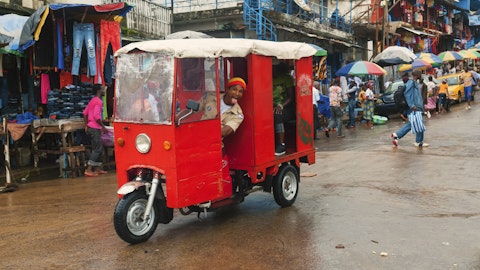In this article, we will look at the 10 countries with the highest percentage of women in the workforce. We have also discussed the state of female workforce globally and its challenges in another article. If you are interested in reading about that along with a more extensive list, head straight to the 25 Countries with the Highest Percentage of Women in the Workforce.
10. Moldova
Female Labor Force Participation Rate: 72.2%
While the female labor force participation is high, young women, especially, encounter barriers to entering the job market. Traditional gender norms perpetuate this disparity, focusing on women’s role in childcare and household responsibilities, hindering their pursuit of careers and entrepreneurial endeavors. While legislative measures have been introduced to address workplace gender equality, implementation lags.
9. Kenya
Female Labor Force Participation Rate: 72.2%
Women’s participation in the labor force in Kenya has seen notable developments in recent years, driven by various factors including increased access to education and economic opportunities. However, gender disparities persist, with women still facing challenges such as limited access to formal employment, wage gaps, and cultural norms that prioritize men in certain sectors.
8. Liberia
Female Labor Force Participation Rate: 72.4%
In Liberia, women’s involvement in agriculture is pivotal, constituting a significant portion of the sector’s workforce. They represent approximately 80% of agricultural labor and contribute to 93% of food crop production. Despite this, they encounter barriers such as limited access to inputs and financing.
7. Angola
Female Labor Force Participation Rate: 72.8%
According to the Women, Business, and the Law 2023 report, Angola scored 79.4 out of 100, surpassing the regional average in Sub-Saharan Africa (72.6) and the global average (77.1). Notably, Angola scored 100 in areas such as women’s freedom of movement, decision to work, entrepreneurship, and property rights. However, challenges persist in areas affecting women’s earnings, work post-childbirth, and pension benefits.
6. Ethiopia
Female Labor Force Participation Rate: 74.8%
In Ethiopia, the influx of foreign investment and the establishment of industrial parks created job opportunities, particularly for women. Before the COVID-19 crisis, around 86,000 workers were employed in these parks, with approximately 80% of them being women. Despite expectations, research found that these job opportunities did not translate into increased political participation for women.
5. Tanzania
Female Labor Force Participation Rate: 77.1%
In Tanzania, the labor force participation rate reflects a significant gender imbalance, with women constituting over 75% of the agriculture workforce. Despite their substantial contribution, women face disparities in pay and land ownership. According to a 2014 study, Tanzanian women work 432 minutes daily, with 238 minutes unpaid, compared to men’s 408 minutes with only 64 minutes unpaid.
4. Mozambique
Female Labor Force Participation Rate: 78.4%
The majority of working women, over 80%, are in agriculture, while a mere 3% are in industry. USAID’s Engendering Utilities initiative collaborated with Electricidade de Moçambique (EDM), the country’s power utility, to address gender gaps. Despite serving nearly 30% of Mozambique’s population, only 18% of EDM’s 3,400 employees are women, with minimal representation in technical or leadership roles.
3. Burundi
Female Labor Force Participation Rate: 78.8%
In Burundi, cultural norms have increasingly supported women’s economic roles, encouraging their engagement in various sectors. Government policies promoting gender equality and women’s empowerment have opened up opportunities. Additionally, economic necessity often drives women to seek employment to support their families. Education initiatives have also played a crucial role in enhancing women’s skills and qualifications for the job market.
2. Madagascar
Female Labor Force Participation Rate: 82.6%
In Madagascar, a notable proportion of employed women are contributing family workers (14% of women vs. 5% of men), indicating their limited access to formal employment opportunities. Additionally, the gender wage gap persists, favoring men by 28.9 percentage points. These challenges are compounded by high rates of intimate partner violence, experienced by 41% of women, and child marriage affecting 38.8% of Malagasy women ages 20-24. Such circumstances curtail women’s decision-making power and perpetuate economic and social inequalities.
1. Solomon Islands
Female Labor Force Participation Rate: 82.7%
In the Solomon Islands, the Waka Mere program led to substantial improvements in women’s participation in the workforce. With over 6,500 employees impacted, the initiative focused on promoting women in leadership, creating supportive workplaces, and increasing opportunities in traditionally male-dominated roles. The results were impressive: the proportion of employees feeling unsafe at work dropped from 25% to 10%, with some companies reporting a 20% increase in employee confidence in grievance mechanisms. Additionally, 80% of women leader trainees received promotions or new responsibilities.
In 2022, 82.7% women participated in the country’s workforce, making Solomon Islands the country with the highest percentage of women in the workforce.
Insider Monkey focuses on uncovering the best investment ideas of hedge funds and insiders. Please subscribe to our free daily enewsletter to get the latest investment ideas from hedge funds’ investor letters by entering your email address below. You can also take a peek at 25 Countries with Highest Percentage of Females and 25 Best US Cities for Solo Female Travelers.





